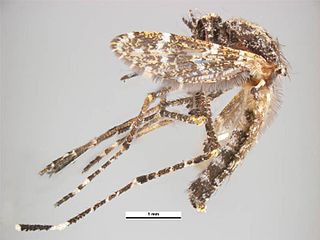Related Research Articles
Culex (Culex) tritaeniorhynchus is a species of mosquito and is the main vector of the disease Japanese encephalitis. This mosquito is a native of northern Asia, and parts of Africa. Females target large animals for blood extraction, including cattle and swine, and are strongly anthropophilic.
Anopheles (Cellia) tessellatus is a species complex of zoophilic mosquito belonging to the genus Anopheles. It is found in India, and Sri Lanka, Bangladesh, Cambodia, China, Indonesia, Malaysia, Laos, Maldives, Myanmar, Nepal, Philippines, Taiwan, Thailand and Vietnam. It is first described from Sri Lanka. Larva are known to found from dirty stagnant water in sun or shady habitats. Adults are zoophilic. It is not regarded as a malaria vector, but is a secondary vector of Wuchereria bancrofti in Maldives.

The Aedeomyia mosquito, Aedeomyia (Aedeomyia) catasticta, is a species of zoophilic mosquito belonging to the genus Aedeomyia. It is found in India, Sri Lanka, Hawaii, Southeast Asian countries and Australia.
Culex (Culiciomyia) bailyi is a species of zoophilic mosquito belonging to the genus Culex. It is found in India, Sri Lanka, Thailand, Cambodia, Indonesia, Malaysia, Myanmar, Papua New Guinea, Philippines and New Guinea.
Culex (Lophoceraomyia) bicornutus is a species of zoophilic mosquito belonging to the genus Culex. It is found in India, Sri Lanka, China, Japan, Malaysia, Myanmar, Thailand, and Vietnam.
Culex (Eumelanomyia) brevipalpis is a species of mosquito belonging to the genus Culex. It is found in India, Sri Lanka, Thailand, Bangladesh, Pakistan, Philippines, Singapore, Cambodia, Indochina, China, Taiwan, Ryukyu-Retto, New Guinea, Maluku, Indonesia, Malaysia, Myanmar, Japan, Vietnam and Bismarcks.
Culex (Eumelanomyia) castrensis is a species of mosquito belonging to the genus Culex. It is found in India, and Sri Lanka
Culex (Culiciomyia) fragilis is a species of mosquito belonging to the genus Culex. It is found in India, Sri Lanka, Borneo, Malaysia, Cambodia, Indonesia, Malaysia, New Guinea (Island); Papua New Guinea, Philippines, Solomon Islands, Thailand, and Vietnam.
Culex (Lutzia) fuscanus is a species of mosquito belonging to the genus Culex. It is found in China, India, Indonesia and Sri Lanka They are natural predators of disease causing mosquito larva such as Aedes aegypti, Anopheles subpictus, and Culex tritaeniorhynchus.
Culex (Culex) fuscocephala is a species of mosquito belonging to the genus Culex. It is found in Indonesia, and Sri Lanka, Bangladesh, Cambodia, China, Guam, Hong Kong, Indonesia, Japan, Laos, Malaysia, Myanmar, Nepal, Pakistan, Philippines, Singapore, Thailand, Timor, and Vietnam. It is a vector of Japanese encephalitis virus.
Culex (Culex) gelidus is a species of mosquito belonging to the genus Culex. It is found in India, Sri Lanka, Bangladesh, Cambodia, China, Hong Kong, India, Indonesia, Japan, Laos, Malaysia, Myanmar, Nepal, New Guinea (Island); Papua New Guinea, Pakistan, Philippines, Taiwan, Thailand, Vietnam. In 1976, it was identified as a major vector of Japanese encephalitis virus, in India. From an experiment, it was evident that aqueous solution of Calotropis gigantea leaves possess larvicidal activity, mosquito repellent activity and ovicidal activity against Culex gelidus.
Culex (Lutzia) halifaxi is a species of mosquito belonging to the genus Culex. It is found in Australia, New Zealand, Indonesia and Sri Lanka
Culex (Oculeomyia) infula is a species of mosquito belonging to the genus Culex. It is found in Bangladesh, India, Indonesia, Malaysia, Myanmar, Nepal, Philippines, Singapore, Sri Lanka, Thailand, and Vietnam. Adults mainly feeds on cattle but infrequently shows a low proportion of human and bird blood meals. Larvae can be found in water courses with high content of algal populations. In 1998, the species was identified as a vector of Japanese encephalitis virus.
Culex (Lophoceraomyia) mammilifer is a species of mosquito belonging to the genus Culex. It is found in Cambodia, China, India, the Andaman Islands, Indonesia, Malaysia, Philippines, Sri Lanka, and Thailand.
Culex (Culex) mimulus is a species of mosquito belonging to the genus Culex. It is found in Australia, Bangladesh, Cambodia, China, Hong Kong, India, Indonesia, Malaysia, Myanmar, Nepal, New Guinea (Island); Papua New Guinea, Pakistan, Philippines, Singapore, Sri Lanka, Thailand, Taiwan and Vietnam. Larvae can be found from agro wells and adults are malaria vectors.
Culex (Eumelanomyia) pluvialis is a species of mosquito belonging to the genus Culex. It is found in India, Malaysia and Sri Lanka.
Culex (Culex) pseudovishnui is a species complex of mosquito belonging to the Culex vishnui group of the genus Culex. It is found in Bangladesh, Cambodia, China, Hong Kong, India, Indonesia, Iran, Iraq, Japan, South Korea, Laos, Macau, Malaysia, Nepal, New Guinea (Island); Papua New Guinea, Pakistan, Philippines, Singapore, Sri Lanka, Thailand, Taiwan and Vietnam. It is a major vector of West Nile virus, and Japanese encephalitis virus Larvae can be found from the edges of rice fields. Adults can bite vertebrates from both indoor and outdoor places with a peak biting time on 7pm onwards.
Culex (Culiciomyia) spathifurca is a species of mosquito belonging to the genus Culex. It is found in Cambodia, India, Indonesia, Malaysia, Maldives, Borneo, Java, Philippines, Philippines, Singapore, Sri Lanka, Irian Jaya, Maluku, and Thailand. This mosquito shows unique male terminalia with bifurcate gonostylus, which can used to differentiate it from other species. Larva and pupa can be found in tree holes associated with mangrove ecosystems. It is a potential vector of Wuchereria bancrofti, but human bitings are very rare.
Culex (Culex) whitmorei is a species of mosquito belonging to the genus Culex. It is found in Australia, Bangladesh, China, India, Indonesia, Japan, South Korea, Laos, Malaysia, Nepal, New Guinea (Island); Papua New Guinea, Pakistan, Philippines, Russia, Sri Lanka, Sudan and South Sudan, Taiwan, Thailand, and Vietnam.
References
- ↑ "An annotated checklist of mosquitoes of Sri Lanka" (PDF). Man and Biosphere Reserve of Sri Lanka. Archived from the original (PDF) on 25 June 2016. Retrieved 3 February 2017.
- ↑ "Species Details : Culex bitaeniorhynchus Giles, 1901". Catalogue of Life. Retrieved 3 February 2017.
- ↑ "bitaeniorhynchus Giles". Systematic Catalog of Culicidae. Retrieved 3 February 2017.
- ↑ "Culex (Ocu.) bitaeniorhynchus". Walter Reed Biosystematics Unit. Retrieved 3 February 2017.